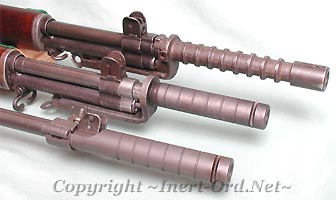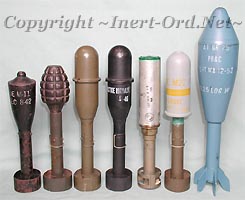| (Click a picture to go to that page) | |
 |
Rifle Grenade Equipment
Spigot Launchers, & Accessories |
 |
Rifle Grenades HEAT, Fragmentation, Practice, Signals |

|
Launching Adapters
Hand Grenade "Projection Adapter" |
|
|
|
Historical Background
During the First World War the United States, lacking a suitable rifle grenade system of its own, used the French V-B cup-launched design, adapted to fit the Springfield and Enfield rifles. By 1928 this system was declared obsolete. A replacement was not aggressively pursued, as some military authorities questioned the future need for rifle grenades. By 1940, it was all too apparent that the capacity to propel grenades farther than could be achieved by hand was still very important. Rather than continuing with the cup design, a simple clamp-on spigot approach was evaluated and adopted in 1941. Two variations (M1 & M2) were issued for the M1903 and M1917 rifles, respectively. The semi-automatic M1 Garand rifle, just beginning to be issued to troops, proved to be a bit more difficult to adapt. A suitable launcher design (M7) was not in production until late 1943. A negative feature of the M7 grenade launcher was it disconnected the semi-automatic function of the rifle. This made the M1 rifle a less than desirable platform for launching grenades. The M1903 Springfield remained the preferred weapon for that. It wasn't until 1945 that the problem was solved with the adoption of the M7A1, too late to see service in WWII. The M1 Carbine was also used to fire rifle grenades. The M8 launcher developed for it was also a simple clamp-on device, similar to the M1 & M2. Since semi-automatic function was not affected it was a popular design, despite the fact that firing grenades produced a large amount of recoil due to the Carbine's light weight. The M8 continued to be standard issue after the war. |
| (Click a picture to go to that page) | |
 |
Rifle Grenade Equipment
Spigot Launchers, & Accessories |
 |
Rifle Grenades HEAT, Fragmentation, Practice, Signals |

|
Launching Adapters
Hand Grenade "Projection Adapter" |